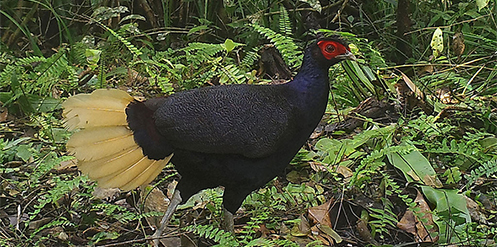June 11, 2018
Meet the Malay Crestless Fireback (Lophura erythrophthalma), known in Indonesia as Sempidan merah. The bird is part of the pheasant family, belonging to the larger Phasianidae family.
There are two subspecies of the Malay Crestless Fireback which have been recognized – Lophura erythrophthalma erythrophthalma, which is native to Sumatra in Indonesia and Malaysia, and the Lophura erythrophthalma pyronata, found in Borneo.

The Malay Crestless Fireback has a distinguishing physical feature, with facial skin which is bright red that plays an important part in courtship displays. Males have bills which are greenish in colour, while females have black bills.
Both genders are generally blackish in colour, with fan-shaped tail feathers. The easiest way to tell the difference in sex between the adults is that male crestless firebacks have dark chestnut rumps and cinnamon-buff tail feathers, while females have black tail feathers.
Male crestless firebacks measure between 47 and 51cm, while females are slightly smaller, measuring 42 to 44cm.
The Malay Crestless Fireback emits somewhat unique sounds – low clucking when it is foraging, and loud ‘kaks’ when it is alarmed.
The species’ breeding season is from April to June, and it has a gestation period of 24 days.
The bird inhabits lowlands in subtropical or tropical moist and evergreen forests. The Malay Crestless Fireback feeds throughout the day by scratching up fallen leaves and eating the small animals exposed, including termites, ticks and grubs. It also consumes vegetable matter and fallen fruit.
The Malay Crestless Fireback holds a Vulnerable (VU) conservation status issued by the International Union for Conservation of Nature (IUCN). VU species are species with a very high risk of extinction with a current population size of fewer than 1,000 individuals.
This is primarily a result of rapid habitat loss – Sumatra lost almost 30 per cent of its evergreen forest from 1985 to 1997 because of commercial logging, illegal logging and land conversion. However, being hunted for food may be an additional threat to the species.
The Restorasi Ekosistem Riau (RER) team has recorded the Malay Crestless Fireback as a common species within the Kampar Peninsula, meaning that it is typically seen or heard in the area.
It is also recorded as a resident species in RER, meaning that it is a species that is present throughout the year. The RER team observed at least three chicks in the area in May 2017.
The Malay Crestless Fireback is one of the 299 species of birds included in a bird checklist which was last year published by the RER.
View the full annotated checklist of bird species in RER here.
Many animals, including rats, squirrels, hedgehogs and wild boars enjoy consuming Meranti seeds. As Meranti Paya trees bloom and bear fruit as a concerted species, there is a surplus in the number of seeds available throughout that time. The species is relatively safeguarded then, in that not every tree’s seeds will be victim to the animals at once.
The flowering season is a good opportunity to collect seeds and tree seedlings for the purpose of forest restoration as well as conservation of the CR species.
However, the period between one flowering season to the next differs for each Meranti species. This was the first time that the Meranti Paya species in the Kampar Peninsula has been observed as bearing fruit since 2010, when the existing trees were first planted with seeds. Based on this, it seems that the flowering period for Meranti Paya in the Kampar Peninsula is about seven years.
By: Muhammad Iqbal – RER Ecologist
Meet the Malay Crestless Fireback, a shy bird that holds a #Vulnerable status since their population is decreasing due to habitat loss. Have you seen one before? #ExploreRER https://t.co/prHmCFSLpz pic.twitter.com/UX6IQEEUyV
— RER (@RER_official) June 13, 2018